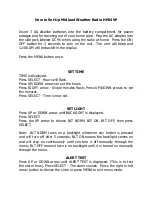
Noise
Suppression
2. Press the push-to-talk (PTT) button on the microphone and hold it down. Hold the
microphone
four to six inches from your mouth and speak at a. normal level.
Announce the call letters of the station you are calling, followed by your call letters.
Repeat if necessary. To receive a reply, sign off and repeat the call letters of your
station.
PA (Public Address)
1. Connect a external PA speaker to the PA jack on the rear panel.
3. Press the push-to-talk button on the microphone and talk into the mic. Your voice
will be heard from your external speaker.
NOTE:
The volume control on the transceiver does not control the speaker output
during PA speaker.
Tune-up
Before
beginning
any special
noise
suppression
steps,
be sure that
the
vehicle is well-tuned.
Clean and tighten
all connections,
including
alternator,
battery,
regulator,
and coil connections.
Perform
the following
maintenance
steps as necessary: Solder any cr(mped spark plug or distributor
leads; if you
must
use solid-wire
leads,
clean
and
regap
or replace
spark
plugs
and
ignition
points;
and check
and clean alternator
rings or generator
brushes.
Retune the engine
at the manufacturer's
recommended
intervals.
Corrective
Steps
In order to find and eliminate
the maximum
number of noise sources that are
present in any vehicle,
start the strong sources,
then work back. To be sure
the noise comes from your vehicle and not outside it, drive to a location that is
free
of
man-made
electrical
interference
(such
as
noisy
power
lines,
industrial
noise, or other vehicles).
Test for noise with a weak signal on the
channel and the engine off. Then start the engine. Ignition
noise will probably
be present at all engine speeds. If it is severe, it will make a normally
readable
signal unreadable.
To reduce ignition
noise, install resistor-type
spark plugs. If non-resistance
ignition
wiring
is used, install a 10 k-ohm suppressor
resistor at each spark
plug tower of the distributor.
Install a coaxial capacitor
as close as possible to
the ignition
coil primary.
A "whining"
noise which
varies with engine
speed and continues
with the
ignition
turned
off
and
the
vehicle
coasting
in gear
characterizes
the
alternator.
Check and clean it and install an alternator
filter.
An irregular,
clicking
sound
which
disappears
at a slow
idle may be the
voltage regulator.
Install a 4-ohm carbon resistor as close to the field terminal
••
of the regulator
as possible,
then a .002 uF capacitor
in series with and as
close to the resistor
as possible.
Connect
the capacitor
to ground.
See the
detail drawings
on next page.
Irregular
popping
noises
which
vary
with
road
surfaces
indicate
static
discharge
at any of several locations
in the vehicle. Tighten
loose nuts and
bolts and bond large areas such as the fenders, exhaust pipe, firewall,
etc. to
the frame with lengths of heavy wire braid. Contact
a local electronics
parts
or automotive
electrical
service company
to purchase
the necessary
items.
Additional
information
is
available
in
the
Radio
Amateur's
Handbook
published
by the ARRL.
Содержание hy-range II 671B-PR
Страница 1: ......
Страница 11: ...O 1 uF COAXIAL 0 1 COAXI ...
































